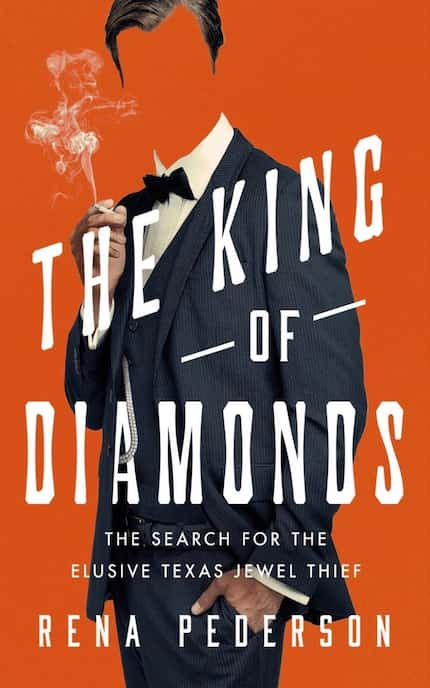It was a warm night downtown on April 4, and the sold-out audience inside the Dallas Museum of Art leaned in as Rena Pederson talked about her true-crime tour-de-force, King of Diamonds.
“An extremely talented jewel thief – Houdini-like – stole millions from the richest people in Dallas and got away with it,” she told the crowd in her West Texas accent, as she sat in an armchair under a giant overhead screen, her silver hair catching the light. “So who was he? How did he do it? And why couldn’t they catch him?”
I’d seen many literary bigwigs cast their spell at Arts & Letters Live – Chuck Klosterman, David Grann, Lauren Groff – but I’d never seen an audience slip inside the palm of a speaker so snugly. Like the author herself, a spry 76, many attendees lived on the AARP side of things. Gray hair and tortoise-shell glasses, silk wraps and pressed slacks.
Maybe it was because the drama of the book hit so close to home. The real-life King of Diamonds plagued Dallas high society from the late 1950s to 1970, grabbing headlines and confounding police as he rummaged through the drawers and private boudoirs of the city’s untouchable families on exclusive streets with names like Strait, Park and Beverly. The Murchisons, the Hunts, the Richardsons – families whose names are emblazoned on bridges and buildings – fell victim to the cunning cat burglar who moved to the beat of the city’s social calendar, slipping in side windows and back doors after debutante balls or charity galas to snatch rare diamond rings and showstopping necklaces worn to dazzle.
King of Diamonds, released earlier this month, unfolds this gripping saga, interspersed with Pederson’s own dogged quest to crack the 50-year cold case, but it was more than a local connection that ensnared the crowd. Drawing on 200 interviews conducted over six years, the former Dallas journalist ropes in some of the most legendary characters in Dallas’ pre-Kennedy glory days: Jack Ruby, Candy Barr, Carlos Campisi, the Dixie Mafia. Some names were unfamiliar to me but shouldn’t be, like Nancy Hamon, the society maven who once rode into one of her outré parties on an elephant.

Vivid photos flashed on the giant screen behind Pederson, though few elicited a gasp like the stunning interior of the Graf House, an early target of the jewel thief. A modernist mansion in Preston Hollow designed by Edward Durell Stone (the man behind New York’s Museum of Modern Art), the house boasted an only-in-Dallas opulence that included a dining table improbably situated on a circular slab in the middle of an indoor swimming pool, a dinner party on the world’s smallest island.
But as Pederson grew closer to the story, she also began touching the seedy underbelly of a city that still holds many secrets. Mafia, spies, celebrities, gambling dens, sex trafficking – all of it wrapped up in the glittering bow of high society.
“This is one of the best books about Dallas I’ve ever read,” bestselling author Bryan Burrough told me by email, and he’s quite the authority, since his 2009 book The Big Rich covers similar territory. Burrough, a longtime Vanity Fair contributor who lives in Austin, was the first person to tell me about Pederson’s new book, which sat in PDF form on my laptop until a journalist friend texted me about it. “I can’t tell you the last time I gobbled up a book like this,” she wrote, thus kickstarting my own obsession.

I was still on chapter 11 (of 41) when I stepped into a crowded elevator in the DMA’s parking garage earlier this month, where well-heeled ticket holders theorized about who did it, and I was so eager to avoid any spoilers that I literally covered my ears like a child around too much cussing.
Rumor had it, Pederson named the real-life King of Diamonds in the book. She cracked the case! Inside the bustling theater, stragglers heading to their seats, I passed true-crime great Skip Hollandsworth, arm draped casually over the wooden armrest of his chair.
“Why is this book so good?” I asked, and the author of more Texas Monthly barn burners than I care to name – at least of two of which, Bernie and the upcoming Hit Man, have been adapted for film – blinked a few times as though I’d asked a very simple question, and then said, “Because it was only her story to tell.”

I met Pederson inside the Statler, the mid-century hotel that features in her book and abuts The Dallas Morning News offices. These days, Pederson lives in Austin, closer to her grandchildren (the book is dedicated to them), but she spent much of her career in Dallas, where she was the first female editorial page director and then vice president of The News. I walked into Overeasy, an upscale diner on the first floor, to find her tapping on her phone.
“Isn’t that the great thing about email?” she asked me, as the hostess led us to a long booth. “You always have a friend.”
In person, Pederson is 5′1″ and casually stylish. As she writes in King of Diamonds, “I was as unassuming as Agatha Christie’s rumpled Miss Marple, but without the hat and knitting.” Rumpled, no, but unassuming, yes. I couldn’t help thinking of Joan Didion’s line in Slouching Towards Bethlehem: “My only advantage as a reporter is that I am so physically small, so temperamentally unobtrusive, and so neurotically inarticulate that people tend to forget that my presence runs counter to their interests. And it always does. That is one last thing to remember: Writers are always selling somebody out.”
Pederson wasn’t inarticulate either. (I doubt Didion was, for that matter, but we never met for breakfast.) As Pederson and I chatted over lattes, she struck me exactly as she had in print: Texas-friendly and whip-smart. A copy of the hardback sat at the table’s edge, and the striking orange cover caught the eye of a random guy who stopped at the table.
“She wrote that,” I told him, and he did a double take at the little white-haired lady before saying, “Oh, snap.”

Rena Pederson first met the King of Diamonds the way most people did back then: through the headlines. She was 23 when she moved to Dallas in 1970, straight from grad school in New York to work for United Press International, better known as UPI. Back then, journalism was all teletype machines and chain-smoking at the desk, and Pederson was working the overnight shift when she read about the unsolved mystery of the burglar who, like Cary Grant in To Catch a Thief, had committed the perfect crime.
Whoever the King of Diamonds turned out to be – an architect, a society writer, the wayward son of a Las Vegas casino owner, there were theories aplenty – the trail went dead over the next decades as Pederson’s career caught fire. She became a heavyweight at The News and interviewed Margaret Thatcher, Fidel Castro and Princess Grace. During the Bush administration, she worked as a senior speechwriter and advisor at the U.S. Department of State. In 2001, she wrote her first book, What’s Next?, about women who reinvent themselves in midlife, and she landed on The Oprah Winfrey Show.
“Should I send her a note saying I finally followed my own advice?” Pederson wrote me later by email. “I think I will.”
Pederson had technically retired by the time she cracked her knuckles on King of Diamonds six years ago. But she was still a writer in her bones and had been ever since she was a teenager working at the San Angelo Standard-Times. She was too young to drive, so the cops stopped by the paper to pick her up if a crime hit. Hard to beat that kind of adventure, although the discovery at the heart of King of Diamonds might come close.
It’s bizarre the cops had never tracked down the culprit, though they got close. The book details the enormous lengths detectives went to catch the guy, but November 1963 did leave them with other mysteries to solve: the assassination of a president, for instance.
Half a century later, as the epic jewel thief’s story threatened to fade from memory, Pederson couldn’t stop tugging on the thread. “Since 1970, I had endured five publishers, one husband, two rambunctious sons, and a lifetime of newspaper deadlines,” she wrote in the book’s introduction. “I could look for the thief with seasoned eyes.”
And did she ever. King of Diamonds is a how-to-manual for aspiring gumshoe reporters. Strangers hang up on Pederson, sometimes angrily, she plumbs records and court transcripts, she sends flowers to subjects reluctant to speak with her (doesn’t work) and eats fried okra at the Golden Corral with reticent cops (does work). In other words, she displays the nimble fingers and sly entrées of the jewel thief himself, whose identity she reveals at the end of the book, and I would never dare spoil that. (Reasonable questions: Did he act alone? Was he even a he?)

It wasn’t all catch-me-if-you-can good times, however. The underbelly of Dallas has stayed unlit for decades, and there’s a reason. Pederson was nosing around mob ties when strange things started happening. “Look somewhere else,” said a message sent to her house. Her computer got mysteriously hacked. She decided to get a tattoo of a dagger on her right ankle. A talisman, a warning to anyone who underestimated her, though she also got a better alarm system.
“I may be short, but I’m a tough ol’ boot,” she told the crowd at the DMA while speaking with fellow Dallas media pioneer Lee Cullum in the interview portion of her Arts & Letters Live event.
“These women are so inspiring,” Arts & Letters Live director Michelle Witcher whispered to me as the show began. Tough, beautiful, brilliant, funny: Who could be scared of getting older when aging looked like this?
There was one question everyone wanted to know. “Any plans for a movie?” an audience member asked.
“God, I hope so,” Pederson said, never skipping a beat. “Know anyone?”


:no_upscale()/cloudfront-us-east-1.images.arcpublishing.com/dmn/GMQR4VBXORE43C3VGMLHV2OTD4.jpg)
/cloudfront-us-east-1.images.arcpublishing.com/dmn/UY3REWQMXBH3RGEEKTTHMX5H24.jpg)
/cloudfront-us-east-1.images.arcpublishing.com/dmn/ITESS7AAC5VIKBEYJL4HZZPHYA.jpg)
/cloudfront-us-east-1.images.arcpublishing.com/dmn/22MCUCQFHMPKVZQ2WMXX5O437Y.jpg)
/cloudfront-us-east-1.images.arcpublishing.com/dmn/FCYBBP25Y756MKZT24NF6L772U.jpg)